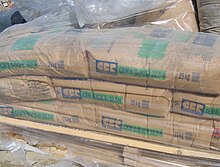
Back Portlandsement AF أسمنت بورتلاندي Arabic পোর্টল্যান্ড সিমেন্ট Bengali/Bangla Portlandský cement Czech Sment Portland CY Portlandcement Danish Zement#Portlandzement German Portlanda cemento EO Cemento Portland Spanish Portland zementu EU


Portland cement is the most common type of cement in general use around the world as a basic ingredient of concrete, mortar, stucco, and non-specialty grout. It was developed from other types of hydraulic lime in England in the early 19th century by Joseph Aspdin, and is usually made from limestone. It is a fine powder, produced by heating limestone and clay minerals in a kiln to form clinker, and then grinding the clinker with the addition of several percent (often around 5%) gypsum. Several types of portland cement are available. The most common, historically called ordinary portland cement (OPC), is grey, but white portland cement is also available. Its name is derived from its resemblance to Portland stone which is quarried on the Isle of Portland in Dorset, England. It was named by Joseph Aspdin who obtained a patent for it in 1824. His son William Aspdin is regarded as the inventor of "modern" portland cement due to his developments in the 1840s.[1]
The low cost and widespread availability of the limestone, shales, and other naturally occurring materials used in portland cement make it a relatively cheap building material. Its most common use is in the production of concrete, a composite material consisting of aggregate (gravel and sand), cement, and water.